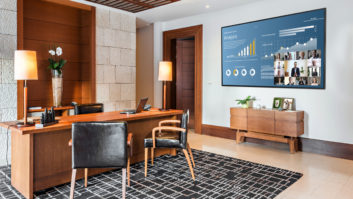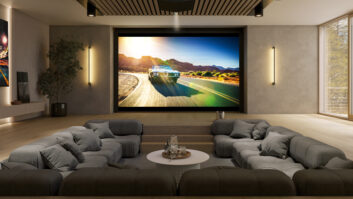Steps That Will Give Your Client A Theater They Really Want

A great home theater is no accident. Designers cannot merely show up with the latest favorite gear, hang it in the proffered space, and bang out extraordinary results.
In my last column, I compared the room itself to the chassis of a high-performance machine— purpose engineered for specified results and able to sustain the power and performance that we plan to equip it with. Because we have carefully engineered that chassis, we must follow through with specification, design, and engineering of the power plant that will drive it.
The power plant represents a system of many parts that combine to deliver the final experience. These parts are broken up into a few subsystems, including the video system, the audio system, control, power, and storage. The specification of each subsystem is, in turn, subject to parameters that include, room size, room configuration, performance expectations, and budget. Additional parameters that the home theater designer must also consider are compatibility, reliability, product knowledge, experience, availability, and support. Finally, each subsystem and the entire theater engine require engineering and documentation to properly deliver a quality home theater result.
FIRST, THE PARAMETERS

The process of creating a “system-intent” or “scope-of-work” document will minimize miscommunication as the project progresses. A common mistake is a result of selecting equipment before the parameters are understood. A typical scenario is where a client is pushing for a quote before the integrator has the opportunity to properly discover the parameters and engineer the chassis. In some cases the dealer may not yet clearly understand the client’s expectations and true budgetary constraints. The resulting equipment specification is likely to miss the mark on several parameters and could set the stage for unsatisfactory results going forward.
The preferred process for home theater system design is this:
■ Initial client interview
■ Letter of intent and design agreement
■ Client discovery
■ Theater design intent and scope of work
■ Functional room design
■ System specification and estimate
■ System engineering and documentation
■ Design integration
Sometimes that engineering discovers flaws in the specification and either a change order has to be negotiated, or the dealer will have to suffer the loss.
The process of creating a “system-intent” or “scope-of-work” document will minimize miscommunication as the project progresses. The next step is the functional room design, which will provide needed information to properly specify the equipment.
SPECIFYING PRODUCTS
CEDIA’s “Recommended Practices for Home” offers performance specification requirements for speakers, processors, amplifiers, cabling, projection, screen and the other technical components. Following these recommendations will ensure, for instance, that speakers are adequate and adequately powered for the designated space, projectors are up to the task of driving the size screen that is properly designated for the space, etc. But producing great results is not just about following a list of specs.
This is where those additional parameters mentioned above come in. The first one is compatibility. A component must be compatible with the application and the other equipment in the system. Compatibility covers a lot of ground, including impedance, connectivity, control protocol, power handling, light output, and aspect ratio. An assembly of high-quality components that are incompatible results in a poorly engineered system.
Reliability, product knowledge, and experience work hand in hand. The only way that a designer can know if a product is reliable is through product knowledge, and that is only available through product experience. However, never experiment with your client’s system. When it comes to “availability,” only specify products that your company is authorized to supply.
ENGINEERING AND DOCUMENTATION
Proper engineering and system documentation is much more than providing a list of components and manufacturer cut sheets. The designer should employ the knowledge, tools, and effort to provide these documents.
Home theater designers and integrators who professionally design and engineer theater systems to their client’s stated and understood expectations will produce dream machines that will deliver great home theater experiences in great home theater rooms. Instead of an accident waiting to happen, these precision home theater engines will prompt proud owners to show off what’s under the hood.
Sam Cavitt (samcavitt@medesign. tv) is president of Paradise Theater, a division of Media Environment Design Inc., located in Kihei, Hawaii, and Carlsbad, California.







